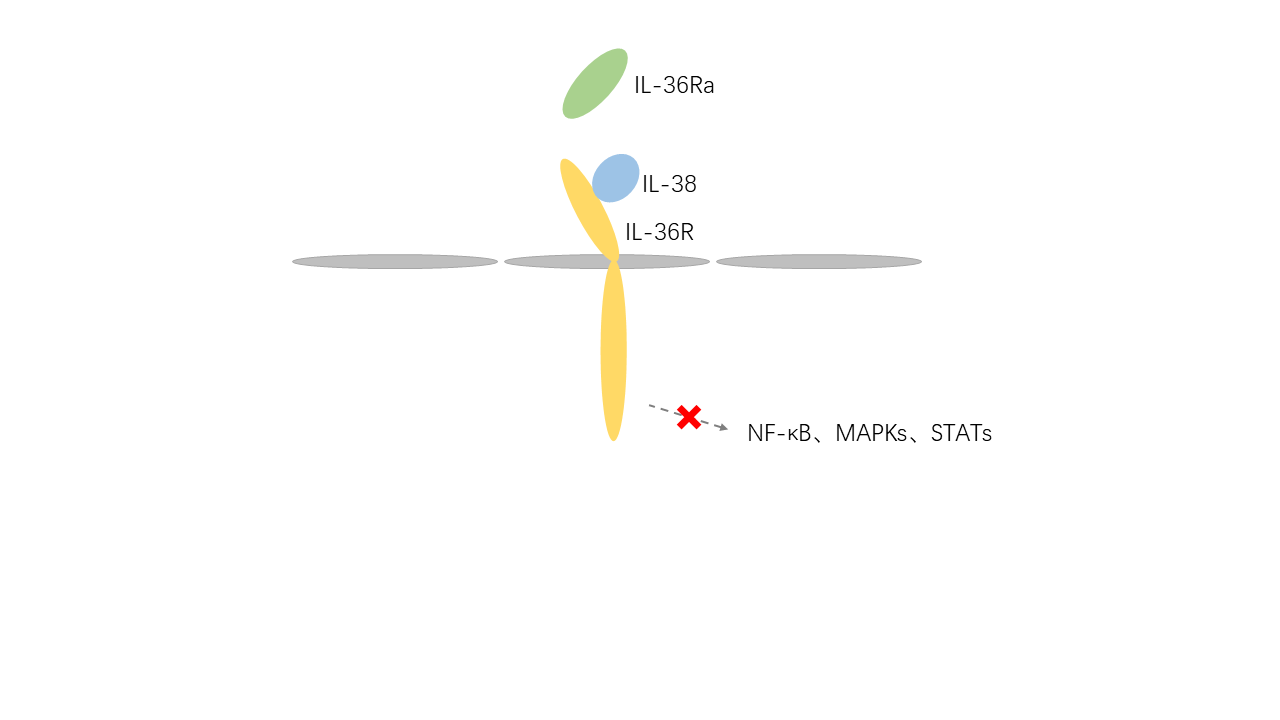Introduction
IL-38 is one of the members of the IL-1 family, which is the same as other IL-1 family members. It lacks signal peptide and caspase-1 cleavage site. IL-38 is widely expressed in immune tissues, such as spleen, thymus, tonsils, etc., and the expression is particularly obvious in skin and tonsil B cells. The expression level is low in the heart, placenta and other non-immune tissues. There is a certain connection between IL-38 and inflammation.
Mechanism and Function
The receptor of IL38 is IL-36R, and its binding ability is even stronger than IL-36Ra, so it plays a role in inflammation mainly through the IL-36Ra pathway. After the combination of Il-38 and IL-36R, it can inhibit the inflammatory pathway of NF-κB and mitogen-activated protein kinase(MAPKs). NF-κB has an effect on the activation of the mammalian target of rapamycin (mTOR), which leads to the influence on the phosphorylation of signal transducer and activator of transcription(STAT)3, which ultimately affects the differentiation of Th17.
In fact, IL-38 has many biological effects. For example, IL-38 has a biological basis as an IL-36R receptor antagonist, and its biological activity is similar to IL-36Ra. It can bind to IL-36R and induce its antagonism. IL-38 can inhibit the production of Th17-related cytokines IL-22 and IL-17 by blocking IL-1R and IL-36R signaling pathways, thereby playing an anti-inflammatory effect. Due to the "macrophage-apoptotic cell" interaction, IL-1 family proteins have the effect of regulating the production of macrophage cytokines. The binding of IL-1R6 and IL-1RAPL1 in the IL-1 receptor and IL-1 family is a necessary condition for the production of apoptosis-inducing cytokines in macrophages. It can reduce LPS, induce the production of IL-6 and IL-8, or inhibit the expression of IL-17 in THP-1 cells, so it plays a positive role in alleviating the inflammatory response under adjusted conditions. IL-38 can also cooperate with IL-36Ra to inhibit the production of IL-8 by peripheral blood mononuclear cells (PBMC) and increase the expression of IL-6.
IL-38 can participate in many diseases. For example, the abnormal expression of IL-38 is linked to the severity of autoimmune diseases. In Crohn, IL-38 expression increases in the synovium and colon of patients, inhibiting the binding of IL-36 and its receptor to protect the body. n K/BxN serum transfer-induced arthritis (STIA), overexpression of IL-38 can reduce collagen induced arthritis (CIA) and STIA's joint swelling and macrophage infiltration. IL-38 can also be seen in other inflammatory reactions. IL-38 is highly expressed in asthma, idiopathic pulmonary fibrosis and drug-induced pulmonary interstitial diseases. In addition, expression of IL-38 is quite high in atherosclerotic plaques. In addition to its effects on blood vessels, IL-38 can also inhibit endothelial cell proliferation and blood vessel formation stimulated by vascular endothelial growth factor (VEGF).
 Fig 1. Mechanism of Signaling
Fig 1. Mechanism of Signaling
Creative Proteomics can provide cytokine detection platform for scientific research. According to different purposes, our dedicated analysts will customize exclusive solutions for you. We aim to provide customers with high-quality and convenient services to help you accelerate the progress of your project.
Our cytokine detection service includes but is not limited to:
- Quantitative and qualitative detection of cytokines in different species
- Quantitative and qualitative detection of cytokine antibodies
- Quantitative and qualitative detection of single/multiple cytokines
Sample requirements
- Sample Types-Blood, serum, plasma, cerebrospinal fluid, cell culture supernatant, tissue homogenate, cell culture medium, urine, tumor, etc.
- Sample Volume-It is optimal for at least 200µl of each sample. This volume allows for triplicate testing of each sample.
Our advantages:
- Efficient design: Multiplex reaction detecting in various methods are available, which can be selected according to different samples and requirements.
- Sensitive Detection: High-quality antibodies are used in the detection process to improve detection specificity and accuracy.
- Reliable results: The feedback results are professional and efficient
Technology platform:
We mainly provide the Luminex cytokine detection platform. Luminex uses fluorescently encoded microspheres with specific antibodies to different target molecules. The different microspheres can be combined freely to a certain extent so that up to 100 analytes can be tested multiple times simultaneously in a single experiment.
The Luminex cytokine assay platform has the following advantages:
- Multiple detection: simultaneous detection of 100 biological targets
- Short experiment time: 1-3 weeks
- High sensitivity: the lower limit of accurate quantification is as low as 0.1 pg/mL
- Save samples: only need a sample volume as low as 25 μL
- Time saving: the experiment process only takes 4 hours
For your different needs, we can also provide the following detection methods:
- Enzyme-linked immunosorbent assay (ELISA)
- Flow cytometry
Workflow

For more information about the IL-38 detection service or need other detection requirements, please contact us.
References:
- Veerdonk F L V D, Stoeckman A K, Wu G, et al. IL-38 binds to the IL-36 receptor and has biological effects on immune cells similar to IL-36 receptor antagonist. Proceedings of the National Academy of Sciences of the United States of America, 2012, 109(8): p.3001-3005.
- Boutet M A, Najm, Aurélie, et al. IL-38 overexpression induces anti-inflammatory effects in mice arthritis models and in human macrophages in vitro. Annals of the Rheumatic Diseases, 2017:1304.



